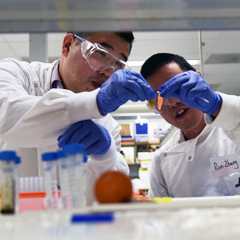Professor Zhi Ping (Gordon) Xu

Nanomaterials for target delivery of drugs, genes and vaccines against the infectious diseases (anti-tumour, anti-bacteria and anti-viruses)
Professor Zhi Ping (Gordon) Xu’s research focuses on controlled preparation of layered double hydroxide (LDH) nanomaterials, calcium phosphate (CaP) nanoparticles, nanoemulsions (NEs), quantum dots (QDs), chemosensors (CSs) and nanosensors (NSs), and their applications in biomedicine and agriculture. The research topics include:
- Functionalisation of these nanoparticles for biomedical use under magnetic, photonic and ultrasonic fields;
- In vitro and in vivo cellular delivery vehicles of chemotherapeutic drugs, such as pharmaceutical drugs, oligonucleotides, siRNA, DNA/RNA segments, heparin and proteins for the treatment of cancer diseases, neuronal diseases and cardiovascular diseases;
- Functionalisation of clay nanomaterials into effective adjuvant of protein vaccines against infectious diseases for humans, animals and plants;
- Functionalisation of nanomaterials for normalisation of tumour microenvironment to enhance the tumour treatment
- Monitoring diseases and treatment progress.
Professor Zhi Ping (Gordon) Xu was an Australian Research Council (ARC) Future Fellow (2013-2016) and UQ VC Senior Research Fellow (2017-2019). Since 2004, He has received a number of fellowships and awards, including an ARC Australian Postdoctoral Fellowship (2005-2007), ARC Australian Research Fellowship (2008-2012), and UQ Foundation’s Research Excellence Award (2009). Professor Xu is an ARC and NHMRC referee.
Industry engagement and collaborations
- Design and Development of Bioclay for Crop Protection (NuFarm)
- Large Scale production of clay nanomaterials (NuFarm)
Funding
Professor Xu and his colleagues have received funding from the ARC and National Health and Medical Research Council (NHMRC) totalling more than $30 million.
Key publications
- Liu, C; Zhang, R; Zhang, W; Liu, J; Wang, Y; Du, Z; Song, B; Xu, ZP; Yuan, J: “Dual-Key-and-Lock” Ruthenium Complex Probe for Lysosomal Formaldehyde in Cancer Cells and Tumors. Journal of the American Chemical Society, Available online in April 2019. doi:10.1021/jacs.8b13898
- Chen, W; Zuo, H; Rolfe, B; Schembri, MA; Cobbold, RN; Zhang, B; Mahony, TJ; Xu, ZP: “Clay nanoparticles co-deliver three antigens to promote potent immune responses against pathogenic Escherichia coli”. Journal of Controlled Release, 292:196-209, 2018. doi:10.1016/j.jconrel.2018.11.008
- Zhang, L; Xie, X; Liu, D; Xu, ZP; Liu, R: “Efficient co-delivery of neo-epitopes using dispersion-stable layered double hydroxide nanoparticles for enhanced melanoma immunotherapy”. Biomaterials, 174: 54-66, 2018. doi:10.1016/j.biomaterials.2018.05.015
- Li, B; Tang, J; Chen, W; Hao, G; Kurniawan, N; Gu, Z; Xu, ZP: “Novel theranostic nanoplatform for complete mice tumor elimination via MR imaging-guided acid-enhanced photothermo-/chemo-therapy”. Biomaterials, 177:40-51, 2018. doi:10.1016/j.biomaterials.2018.05.055
- Li, B; Gu, Z; Kurniawan, N; Chen, W; Xu, ZP: “Manganese-based layered double hydroxide nanoparticles as a T1-MRI contrast agent with ultrasensitive pH response and high relaxivity”. Advanced Materials, 29, 1700373, 2017. doi:10.1002/adma.201700373
- Mitter, N; Worrall, EA; Robinson, K; Li, P; Jain, RG; Taochy, C; Carroll, BJ; Lu, GQ; Xu ZP: “Clay nanosheets for stable delivery of RNA interference as a topical application to protect plants against viruses”. Nature Plants, 3, 16207.1-16207.10, 2017. doi:10.1038/nplants.2016.207
- Chen W; Zhang B; Mahony T; Gu W; Rolfe B; Xu ZP: “Efficient and Durable Vaccine against Intimin β of Diarrheagenic E. Coli Induced by Clay Nanoparticles”. Small, 12, 1627-1639, 2016.
- Liang XW; Wang HL,Grice JE; Li L; Liu X; Xu ZP; Roberts MS: “A Physiologically Based Pharmacokinetic Model for Long-circulating Inorganic Nanoparticles”. Nano Letters, 16, 939-945, 2016.
- Liang, XW; Wang, HL; Zhu, Y; Zhang, R; Cogger, VC; Liu, X; Xu, ZP; Roberts, MS; Grice, JE: “Short- and long-term tracking of anionic ultra-small nanoparticles in kidney”. ACS Nano, 10, 387-395, 2016.
- Zhang, LX; Jia, YB; Yang, JJ; Zhang, L; Hou, SJ; Niu, XY; Zhu, J; Huang, YR; Sun, XY; Xu, ZP; Liu, RT: “Efficient Immunotherapy of Drug-Free Layered Double Hydroxide Nanoparticles via Neutralizing Excess Acid and Blocking Tumor Cell Autophagy”. ACS Nano, 16(8), 12036-12048, 2022.
- Jain, RG; Fletcher, SJ; Manzie, N; Robinson, KE; Li, P; Lu, E; Brosnan, CA; Xu, ZP; Mitter, N: “Foliar application of clay-delivered RNA interference for whitefly control”. Nature Plants 8, 535-548, 2022. https://doi.org/10.1038/s41477-022-01152-8.
- Sun, L; Wang, J; Li, L; Xu, ZP: “Dynamic nano-assemblies based on two-dimensional inorganic nanoparticles: Construction and preclinical demonstration”, Advanced Drug Delivery Reviews 180, 114031, 2022.
- Li, L.; Qian, Y. J.; Sun, L. Y.; Han, F. Y.; Zhang, R.; Wang, P. Y.; Xu, Z. P.: “Albumin-stabilised layered double hydroxide nanoparticles synergised combination chemotherapy for colorectal cancer treatment”. Nanomedicine: Nanotechnology, Biology, and Medicine 102369, 2021.
- Liu, J. P.; Liu, K.; Zhang, L. M.; Zhong, M.; Hong, T. L.; Zhang, R.; Gao, Y. F.; Li, R.; Xu, T. F.; Xu, Z. P.: “Heat/pH-boosted release of 5-fluorouracil and albumin-bound paclitaxel from Cu-doped layered double hydroxide nanomedicine for synergistical chemo-photo-therapy of breast cancer”. J Control Release 335, 49-58, 2021.
- Opoku-Damoah, Y.; Zhang, R.; Ta, H. T.; Xu, Z. P.: “Vitamin E-facilitated carbon monoxide pro-drug nanomedicine for efficient light-responsive combination cancer therapy”. Biomaterials Science 9, 6086-6097, 2021.
- Sun, B.; Zhao, X. H.; Wu, Y. H.; Cao, P.; Movahedi, F.; Liu, J.; Wang, J. J.; Xu, Z. P.; Gu, W. Y.: "Mannose-functionalised biodegradable nanoparticles efficiently deliver DNA vaccine and promote anti-tumour immunity". ACS Applied Materials & Interfaces, 13, 14015-1402, 2021.
- Wang, J. J.; Sun, L. Y.; Liu, J.; Sun, B.; Li, L.; Xu, Z. P.: “Biomimetic 2D layered double hydroxide nanocomposites for hyperthermia-facilitated homologous targeting cancer photo-chemotherapy”. Journal of Nanobiotechnology 19, 351, 2021.
- Yong, J. X.; Zhang, R.; Bi, S. N.; Li, P.; Sun, L. Y.; Mitter, N.; Carroll, B. J.; Xu, Z. P.: “Sheet-like clay nanoparticles deliver RNA into developing tomato pollen to efficiently silence a target gene”. Plant Physiology 187(2), 1-14, 2021.
- Zhang, L. X.; Jia, Y. B.; Huang, Y. R.; Liu, H. N.; Sun, X. M.; Cai, T.; Liu, R. T.; Xu, Z. P.: “Efficient delivery of clay-based nanovaccines to the mouse spleen promotes potent anti-tumor immunity for both prevention and treatment of lymphoma”. Nano Research 14, 1326-1334, 2021.
- Li, B; Hao, GY; Sun, B; Gu, Z; Xu, ZP: “Engineering a Therapy‐Induced “Immunogenic Cancer Cell Death” Amplifier to Boost Systemic Tumor Elimination”. Adv. Funct. Mater. 30, 1909745, 2020.
- Liu, JP; Wu, YL; Fu, C; Li, B; Li, L; Zhang, R; Xu, TF; Xu, ZP: “Charge Reversion Simultaneously Enhances Tumor Accumulation and Cell Uptake of Layered Double Hydroxide Nanohybrids for Effective Imaging and Therapy”. Small 16 202002115, 2020.
PhD and MPhil Supervision
- View current and completed supervisions on UQ Researchers.
Find out more information on how to apply for a Research Higher Degree (MPhil or PhD) with the School. For all enquiries regarding research supervision, please contact hdr.aibn@enquire.uq.edu.au.

